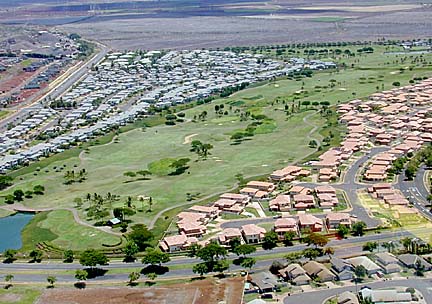


Going West It will be two years this month since Gary and Jackie Lee left Salt Lake and moved their family into their Iwalani home in the Villages of Kapolei in search of a place they could call their own.
West Oahu offers young families
affordable homes and freedomNEW DIGS
Pat Omandam / pomandam@starbulletin.com
So far, the move to West Oahu has worked out great, Jackie Lee said.
"I like it because it's our own place," she said. "We've got really cool neighbors, and it's just neat how it worked out."
On Oahu, Census 2000 population data released earlier this year shows the island county's population has shifted westward over the past decade.
Older communities between Kahuku, south along the Windward Coast, past Makapuu into East Honolulu through about Pearl City saw their populations drop slightly between 1990 and 2000. For example, the population of Waimalu dropped 2 percent, while Kaneohe dropped 1.3 percent.
Many families who left these areas moved mainly so they could buy more affordable homes in growing areas, such as Kapolei, Ewa, Makakilo and Mililani.
In particular, the broad area known as the Kapolei region grew tremendously over the past 10 years, so much so it forced the state to add three new legislative seats there -- two in the state House and one in the Senate -- all at the expense of East Honolulu.
And as businesses and government continue to look toward Kapolei for continued business and residential development, the growth is not expected to end any time soon.
"I think it really is going to be a second city," Lee said.
Lee, along with husband Gary and sons Joshua and Jason, lived in a home in Salt Lake that was owned by her in-laws. The family considered buying an older house there because of its proximity to downtown Honolulu but could not afford it.

Instead, they set their sights on West Oahu and went house-hunting for about six months, before first deciding on a home in Ewa but then finally settling on Kapolei's Village 5, which is called Iwalani. The Lees moved to their new stucco, two-story home in September 1999.Once they became acquainted with the community, Lee said she discovered many of her neighbors were also young families who sought the independence that comes with owning a home.
Although they have long commutes to work, Lee to Kaneohe and her husband to downtown Honolulu, the move has been rewarding, she said.
"People think it is so far ... You have to determine for yourself if it is worth it for you to live out here. I really like it. There's just so much more freedom. It's something that we can call our own," Lee said.
Nationally, the Census Bureau reports about 52 percent of all the people who moved between March 1999, and March 2000, did so for the same reason as the Lees -- to own their own home, live in a less expensive neighborhood or live in a better neighborhood.
The report also found 43 million U.S. residents, or 16 percent of the population, moved to a new residence during that same period.
As far as West Oahu, you can expect more families to move there over the next 10 years, said Willie Espero, a state Representative and former general manager of the Ewa by Gentry Homeowners Community Association.
Espero, (D, Ewa Beach-Waipahu) said the region's main attraction among young families is it continues to offer the first-time home-buyer affordable housing options not available elsewhere on Oahu. And as more people move into these family-centered communities, more schools are built, which in turn attract more people, he said.
"When you look at the prices in town, in Hawaii Kai, and even on the Windward side, they're a little more higher than the ones in the new region (where) they're affordable," Espero said.
Also, people are drawn to the potential of the Kapolei area and want to be a part of its growth. Nevertheless, Espero acknowledged the area's infrastructure, especially traffic through Ewa, remains a top priority if the area is to accommodate further growth.
Here are the year 2000 populations for some areas of West Oahu, with the change from 1990: Growing West Oahu
Source: U.S. Census Bureau
Population Percent 1990 2000 change Makakilo City 9,828 13,156 + 34% Ewa Gentry 1,992 4,939 + 148% Ewa Villages 3,780 4,741 + 25% Mililani Town 29,359 28,608 - 2.6%